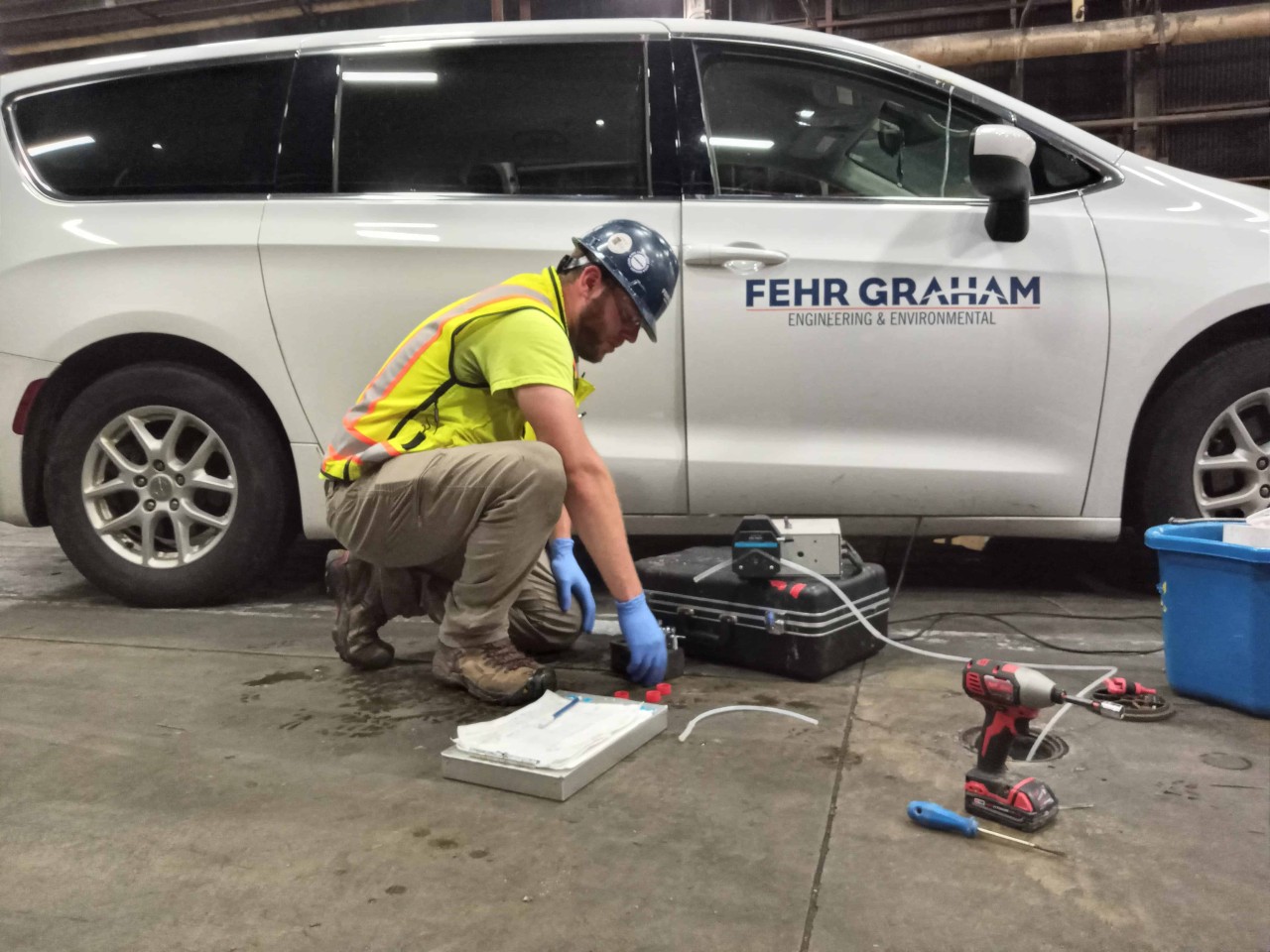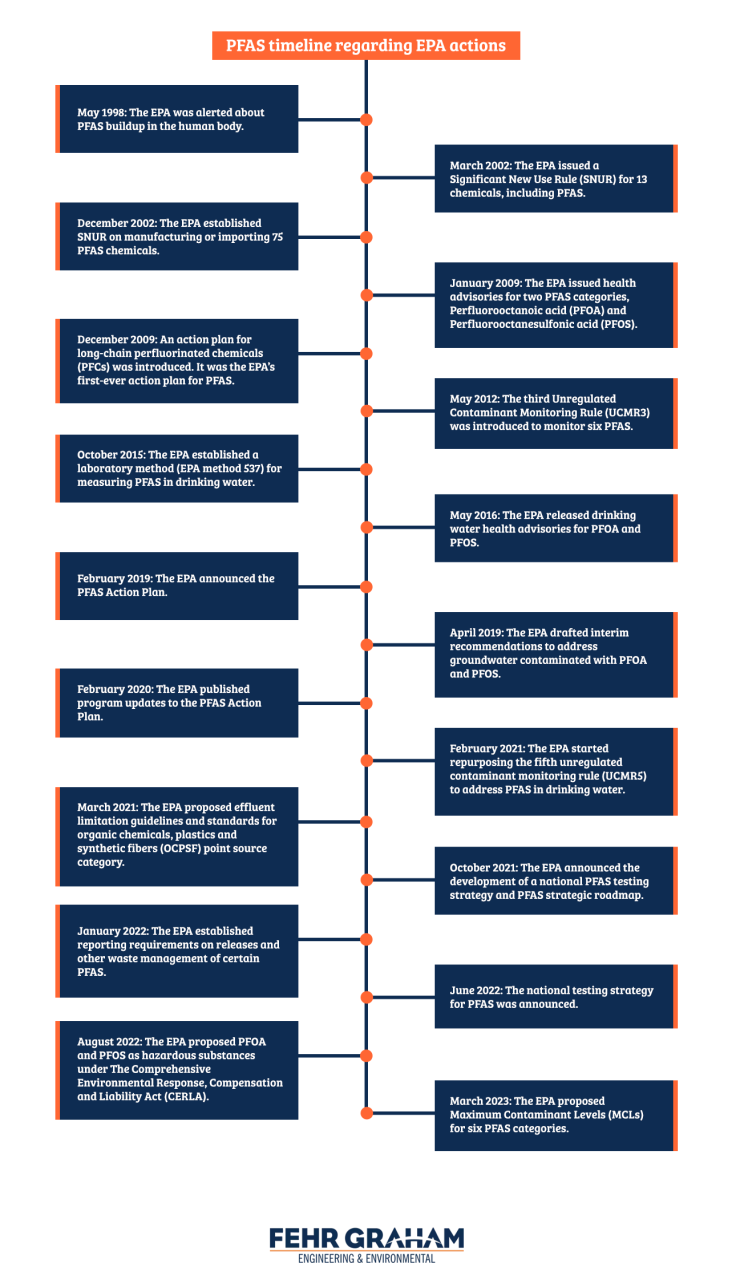PFAS timeline on EPA actions
PFAS, or Per- and Polyfluroalkyl Substances, contamination of groundwater and drinking water exposes us to chemicals that eventually bioaccumulate in our tissues. Preliminary studies indicate the potential health effects of PFAS include altered immune and thyroid function, liver and kidney diseases, adverse reproductive and developmental outcomes and cancer. In recent years, the U.S. Environmental Protection Agency (EPA) has taken significant steps toward regulating PFAS chemicals.
PFAS molecules have limited reactivity and are resistant to heat, water and oil, which hinders their natural degradation and makes it challenging to remove them from water sources using conventional treatment technologies. In this article, we discuss the PFAS timeline and EPA actions and why municipalities should partner with environmental professionals to remove PFAS from groundwater and wastewater.
PFAS timeline and EPA actions
In 1998, the EPA was alerted to the potential health hazards of PFAS chemicals for the first time. However, enforceable regulations on PFAS were not established until recently. The following PFAS timeline highlights some critical EPA actions over the years since PFAS chemicals were first detected.
The EPA's PFAS Strategic Roadmap
The PFAS Strategic Roadmap is a comprehensive whole-of-agency approach to addressing PFAS, taking specific actions and committing to bolder new policies to safeguard public health and the environment. The Roadmap is guided by three primary goals: research, restriction and remediation.
The EPA's approach to addressing PFAS revolves around preventing PFAS from entering the environment and holding polluters accountable for their actions. The agency is also investing in scientific research to understand PFAS better and develop remediation methods.
Since the Roadmap's release in October 2021, the EPA has taken several key actions, including:
- Releasing a final rule to improve reporting on PFAS to the Toxics Release Inventory.
- Publishing a final rule to require reporting for PFAS manufacturing and use in the U.S.
- Finalizing National Enforcement and Compliance Initiatives for 2024-2027, including addressing exposure to PFAS.
- Releasing monitoring data on 29 PFAS in drinking water systems.
- Proposing legally enforceable levels for six PFAS in drinking water.
- Expanding PFAS monitoring in drinking water.
The EPA announced the availability of $2 billion to address emerging contaminants, including PFAS, in drinking water. When taking action on PFAS, the EPA looks forward to regional community engagement, particularly with impacted and disadvantaged communities.
With better awareness about the adverse effects of PFAS and widespread contamination in water bodies, communities need adequate funds and expertise to drive remediation efforts. Partnering with environmental professionals can help secure grants and implement effective and affordable technologies for PFAS removal from groundwater, drinking water and wastewater.
Partner with environmental professionals for PFAS removal from groundwater and wastewater
Community leaders should consider several factors to determine the efficacy of a PFAS removal treatment plan for contaminated groundwater. Leaders should stay updated on proposed federal and state regulations for PFAS in wastewater to plan for treatment processes.
At Fehr Graham, we are committed to helping communities access safe and reliable drinking water while protecting surface water through proper wastewater treatment. Our multidisciplinary team helps you develop water and wastewater treatment solutions and secure funds for system upgrades and construction. With our end-to-end assistance in water and wastewater engineering, we help you comply with proposed standards for PFAS chemicals in drinking water and wastewater.
To learn more about the PFAS timeline on EPA actions and how Fehr Graham can help you determine the best PFAS remediation method, contact us or call 608.329.6400.
 |
Jennifer Buholzer, PE, is a Project Engineer who works on everything from water and wastewater projects to transportation and park projects. She develops relationships with our clients to help them find the most affordable and sustainable solutions. Jen is knowledgeable, results-driven and enthusiastic, offering trainings and webinars and serving as a conference speaker at dozens of events annually. Reach her at |
Collaborative, Insightful, Results-Driven Solutions
Fehr Graham provides innovative engineering and environmental solutions to help improve the lives and communities of our customers.


